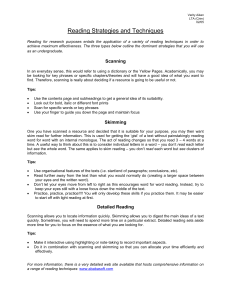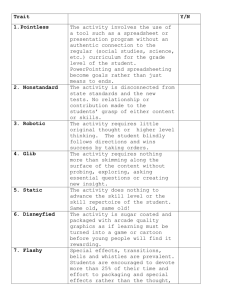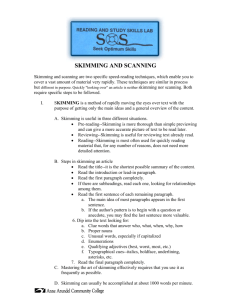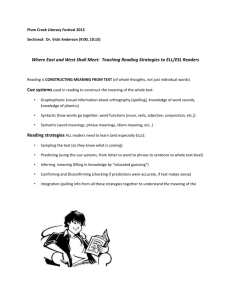Chapter 2 ppt
advertisement
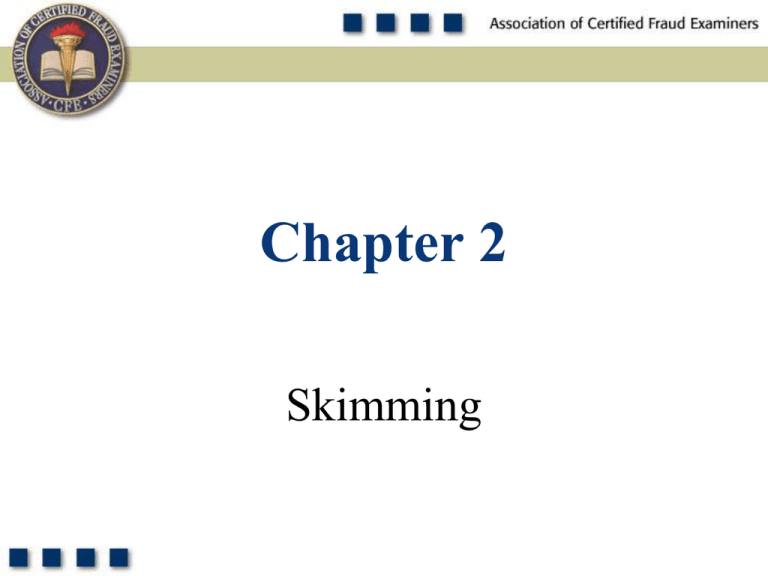
Chapter 2 Skimming 1 Chapter Objectives • Define skimming. • List and understand the two principal categories of skimming schemes. • Understand how sales skimming is committed and concealed. • Understand schemes involving understated sales. • Understand how cash register manipulations are used to skim currency. • Be familiar with how sales are skimmed during non-business hours. • Understand the techniques discussed for preventing and detecting sales skimming. 2 Chapter Objectives • List and be able to explain the six methods typically used by fraudsters to conceal receivables skimming. • Understand what “lapping” is and how it is used to hide skimming schemes. • Be familiar with how fraudsters use fraudulent write-offs or discounts to conceal skimming. • Understand the techniques discussed for preventing and detecting receivables skimming. • Be familiar with proactive audit tests that can be used to detect skimming. 3 Skimming Schemes Skimming Sales Receivables Unrecorded Write-off Schemes Understated Lapping Schemes Refunds & Other Unconcealed 4 Skimming • Theft of cash from a victim entity prior to its entry in an accounting system – “Off-book” • No direct audit trail • Its principal advantage is its difficulty of detection. 5 Asset Misappropriations 2011 Global Fraud Survey % of Asset Misappropriation Cases Median Loss Cash Misappropriations 82.1% $100,000 Non-Cash Misappropriations 19.9% $58,000 Scheme Type 6 Frequency of Cash Misappropriations Fraudulent Disbursements 65.2% Skimming 20.5% Cash Larceny 15.4% 0% 20% 40% 60% Percent of Cash Schemes 80% 7 Median Loss of Cash Misappropriations Fraudulent Disbursements $100,000 Skimming $58,000 Cash Larceny $54,000 $0 $20,000 $40,000 $60,000 $80,000 $100,000 Median Loss 8 Sales Skimming • Employee makes a sale of goods or services, collects the payment, and makes no record of the transaction. • Employee pockets the proceeds of the sale. • Without a record of the sale, there is no audit trail. 9 Sales Skimming • Cash register manipulation – “No sale” or other non-cash transaction is recorded. – Cash registers are rigged so that sales are not recorded on the register tapes. – No receipt is issued. • After hours sales – Sales are conducted during non-business hours without the knowledge of the owners. • Skimming by off-site employees – Independent salespeople – Employees at remote locations – branches or satellite offices away from the primary business site 10 Sales Skimming • Poor collection procedures • Understated sales – Sale is recorded for a lower amount than was collected. – Price of sales item is reduced. – Quantity of items sold is reduced. • Theft in the mail room – incoming checks – Incoming checks are stolen and cashed. – Customer’s account is not posted. 11 Preventing and Detecting Sales Skimming • • • • • Maintain a viable oversight presence at any point. Create a perception of detection. Install video cameras. Utilize customers to detect and prevent fraud. All cash registers should record the log-in and log-out time of each user. • Off-site sales personnel should also be required to maintain activity logs. • Eliminate potential hiding places for stolen money. • Incoming mail should be opened in a clear, open area free from blind spots and with supervisory presence. 12 Receivables Skimming • More difficult than skimming sales – There is a record of the sale. – Collection is expected. • Customers are notified when payment is not received and will most likely complain. • Lapping • Force balancing • Stolen statements • Fraudulent write-offs or discounts • Debiting the wrong account • Document destruction 13 • Lapping Receivables Skimming – Crediting one customer’s account with payment received from another customer – Keeping track of payments becomes complicated. – Second set of books is sometimes kept. • Force balancing – Posting to the customer’s account without depositing the check creates an imbalance condition. – Cash account is overstated so the amount skimmed must be forced in order to balance the account. • Stolen statements – Employee steals or alters the account statement or produces counterfeit statements. – May change the customer’s address in order to intercept the statement 14 Receivables Skimming • Fraudulent write-offs or discounts – Write off the account as bad debt. – Post entries to a contra revenue account – “discounts and allowances.” • Debiting the wrong account – Debit an existing or fictitious A/R. – Wait for the A/R to age and be written off. • Destroying or altering records of the transaction – Often a last ditch effort to conceal the fraud – Makes it more difficult to prove the fraud 15 Preventing and Detecting Receivables Skimming • Succeed when there is a breakdown in an organization’s controls – Mandate vacations. – Mandate supervisory approval. – Train audit staff. • Proactively search for accounting clues. • Perform trend analysis on aging of customer accounts. • Conduct audit tests. 16

